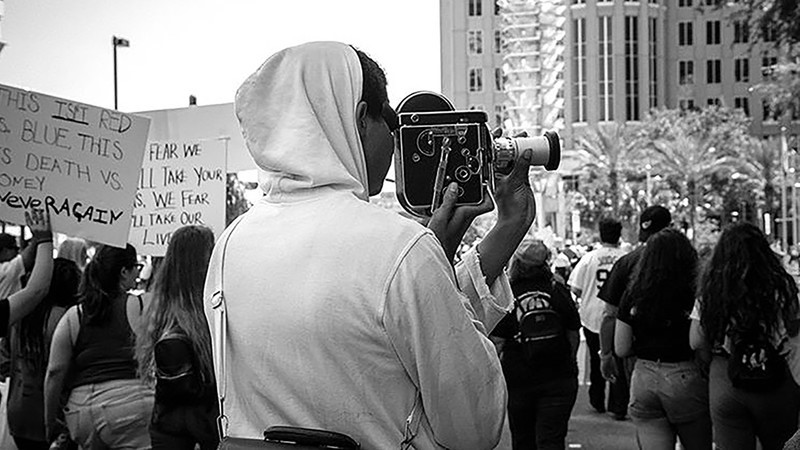Black Liberation Space fosters community for people of color in Iowa City
Founded by Andre Wright and later documented by Trevon Coleman through video, the Black Liberation Space was a temporary location in downtown Iowa City for Black, Latinx, and Indigenous people to come together and feel safe.
Trevon Coleman uses a Bolex 16mm film camera at March For Our Lives in Orlando, FL. The same camera was used to film portions of the documentary.
March 24, 2022
For seven months, paper bags covered the windows at the Black Liberation Space in Iowa City, and it was accessible only through the back door. It was a place for Black, Latinx, and Indigenous people to come together and feel safe, filling a need for the community that Iowa City had previously lacked.
Though the space is no longer in operation, a documentary film captured the conversations and creation that took place there.
Andre Wright, the co-founder of Humanize My Hoodie — a clothing organization focused on ending the killing of Black and Indigenous people across the world — created the Black Liberation Space in May of 2020. Wright said the project was his way of giving to the Iowa City community. Amid cases of police brutality that sparked the 2020 Black Lives Matter movement across the U.S. and the onset of the COVID-19 pandemic, there were numerous factors that made life difficult for Black Americans.
“My way of showing love back to the community was for me to create this space, and then give it back to the community as a way for them to have access to something that they’ve never had before,” Wright said. “It was one of the most radical forms of love that I could show during that time.”
The Black Liberation Space was only a temporary location. Located in a vacant space in downtown Iowa City before it was renovated, Wright said that the space officially closed around six months ago.
Because the location was temporary, Wright spoke with University of Iowa graduate student Trevon Coleman, who had painted at the Black Liberation Space, about documenting the surrounding environment through video. What originally started as a project that was intended to be a film recorder capturing the space transformed into a project with digital and film recordings, and interviews with people who inhabited the space.
The Black Liberation Space documentary has been showing at venues around the Iowa City area, recently at the Big Grove Brewery on Feb. 28. Following the screening, a community discussion took place which featured individuals involved with the space.
Addison Mittelstaedt, events director at Big Grove Brewery and friend of Wright, aided in bringing the Black Liberation Space documentary to the location. Mittelstaedt saw the film when it was screened at FilmScene in Iowa City and later collaborated with Wright to show the documentary and produce a hoodie that would raise money for artists of color that helped design the clothes.
Mittelstaedt said that the event at Big Grove Brewery had around 40 people in attendance and that the smaller group helped contribute to a safe environment for discussion.
“You have to be super vulnerable. And sometimes they fear that the bigger the group is, the less conversation you might have,” Mittelstaedt said. “That wasn’t the case. It was a really great group of people.”
The evolution of the Black Liberation Space
The need for this type of space in Iowa City was clear to Wright. Used by individuals of all ages, a deep community was born out of the project.
“We knew that it was a generous donation of a space for a short period of time while they were planning renovations and the next question is then, ‘what happens next?’” Coleman said. “We knew that there needed to be more permanent spaces like this in town, you know, we don’t have these kinds of dedicated spaces.”
Initially, the Black Liberation Space was intended to be a place for people of color to come together, create art, and discuss issues happening in their communities. Through organic evolution, Wright said that the space transformed into a hub for people to come and feel safe.
Youth participation was a noteworthy aspect of the Black Liberation Space. Wright said that in the past, he had seen teenagers walking around the downtown Iowa City area, without a concrete location to pass time at. Though the space has since closed, but Wright said he still meets with some young community members to teach them digital skills that he has learned through his time designing clothing.
RELATED: Black student involvement on UI campus initiates change
“You would see youth come in here just sometimes to sit on the couch, right? Just to take a breath,” Wright said. “It helped me realize that we didn’t even have a space for us to actually take a breath downtown Iowa City and feel like we could be ourselves.”
Wright described the space as a sort of speakeasy, where the communities involved in the space were the only people who knew of its existence. Wright held back on sharing the community with the press to ensure that the Black Liberation Space would remain safe for those involved.
“We didn’t have an opportunity to fail amongst our other peers without someone really being harsh against our failures or us being singled out about that,” Wright said. “We never had an opportunity to work amongst other black people in a space together. “
While the Black Liberation Space is no longer in operation, Wright is currently working on purchasing another space in Iowa City for a permanent installation called the Wright House of Fashion, which will have a distinct focus on education. He said he hopes to use the future space as a hub for his community to gather, feel safe, and learn from each other.
“It was an opportunity to unshackle their minds, body, and spirit for them to see themselves as something different in our community,” Wright said. “It was a sacred space, meaning that everyone who knew that they came into the space could feel the power from our ancestors — they could feel the spirits from our ancestors.















